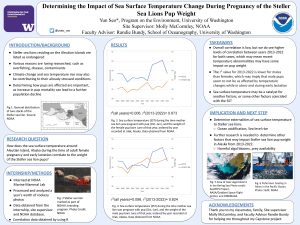TEMPERATURE CHANGES DURING THE PREGNANCY OF THE STELLER SEA LIONS ON THE WEIGHT OF THE PUPS
Steller sea lions are an endangered species under the protection of the Endangered Species Act. Climate change is one of the potential reasons for its unsuccessful population recovery, and such change may pose a threat to the health of the population, as this may cause a decrease in food availability, contaminants, and a variety of other factors. The purpose of this study is to identify a potential reason for why the population hasn’t been recovering, looking for correlation between rising sea temperature with the weight of the pups, as pup weight can be an indicator of population health. I worked with NOAA to analyze information on the sea lion pup weight in tandem with surrounding sea surface temperature, which was used to determine correlation through statistical methods. With this information I came to the conclusion that while recent abnormalities in sea surface temperature may have had an impact on the Steller sea lion pups, it was more through indirect impacts rather than a direct impact, and further research into what other factors impacted by the sea surface temperature may have contributed to changes on the weight of the pups is necessary. This research has the importance of looking at the impacts of anthropogenic carbon emissions on the decline of health of the Steller sea lions at an early point of their life. Advancements of this research may also be used to understand the impacts of climate change on other sea mammals, which will be important to understand future global patterns.
